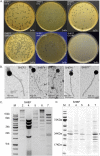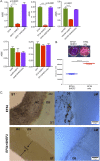Identification of Novel Bacteriophages with Therapeutic Potential That Target Enterococcus faecalis
- PMID: 31451618
- PMCID: PMC6803325
- DOI: 10.1128/IAI.00512-19
Identification of Novel Bacteriophages with Therapeutic Potential That Target Enterococcus faecalis
Abstract
The Gram-positive opportunistic pathogen Enterococcus faecalis is frequently responsible for nosocomial infections in humans and represents one of the most common bacteria isolated from recalcitrant endodontic (root canal) infections. E. faecalis is intrinsically resistant to several antibiotics routinely used in clinical settings (such as cephalosporins and aminoglycosides) and can acquire resistance to vancomycin (vancomycin-resistant enterococci). The resistance of E. faecalis to several classes of antibiotics and its capacity to form biofilms cause serious therapeutic problems. Here, we report the isolation of several bacteriophages that target E. faecalis strains isolated from the oral cavity of patients suffering root canal infections. All phages isolated were Siphoviridae with similar tail lengths (200 to 250 nm) and icosahedral heads. The genome sequences of three isolated phages were highly conserved with the exception of predicted tail protein genes that diverge in sequence, potentially reflecting the host range. The properties of the phage with the broadest host range (SHEF2) were further characterized. We show that this phage requires interaction with components of the major and variant region enterococcal polysaccharide antigen to engage in lytic infection. Finally, we explored the therapeutic potential of this phage and show that it can eradicate E. faecalis biofilms formed in vitro on a standard polystyrene surface but also on a cross-sectional tooth slice model of endodontic infection. We also show that SHEF2 cleared a lethal infection of zebrafish when applied in the circulation. We therefore propose that the phage described here could be used to treat a broad range of antibiotic-resistant E. faecalis infections.
Keywords: bacteriophage; biofilm; capsule; oral microbiology.
Copyright © 2019 Al-Zubidi et al.
Figures






Similar articles
-
Therapeutic potential of a newly isolated bacteriophage against multi-drug resistant Enterococcus faecalis infections: in vitro and in vivo characterization.BMC Microbiol. 2025 Feb 20;25(1):80. doi: 10.1186/s12866-025-03785-z. BMC Microbiol. 2025. PMID: 39979834 Free PMC article.
-
Molecular Basis for Lytic Bacteriophage Resistance in Enterococci.mBio. 2016 Aug 30;7(4):e01304-16. doi: 10.1128/mBio.01304-16. mBio. 2016. PMID: 27578757 Free PMC article.
-
Characterization and Anti-Biofilm Activity of Lytic Enterococcus Phage vB_Efs8_KEN04 against Clinical Isolates of Multidrug-Resistant Enterococcus faecalis in Kenya.Viruses. 2024 Aug 9;16(8):1275. doi: 10.3390/v16081275. Viruses. 2024. PMID: 39205249 Free PMC article.
-
Phage therapy against Enterococcus faecalis in dental root canals.J Oral Microbiol. 2016 Sep 16;8:32157. doi: 10.3402/jom.v8.32157. eCollection 2016. J Oral Microbiol. 2016. PMID: 27640530 Free PMC article. Review.
-
Evaluation of Phage Therapy in the Context of Enterococcus faecalis and Its Associated Diseases.Viruses. 2019 Apr 20;11(4):366. doi: 10.3390/v11040366. Viruses. 2019. PMID: 31010053 Free PMC article. Review.
Cited by
-
Enterococcus Phage vB_EfaS_HEf13 as an Anti-Biofilm Agent Against Enterococcus faecalis.J Microbiol. 2024 Aug;62(8):683-693. doi: 10.1007/s12275-024-00150-z. Epub 2024 Jun 27. J Microbiol. 2024. PMID: 38935316
-
Strategies and mechanisms targeting Enterococcus faecalis biofilms associated with endodontic infections: a comprehensive review.Front Cell Infect Microbiol. 2024 Jul 18;14:1433313. doi: 10.3389/fcimb.2024.1433313. eCollection 2024. Front Cell Infect Microbiol. 2024. PMID: 39091674 Free PMC article. Review.
-
A novel thermostable lytic phage vB_EF_Enf3_CCASU-2024-3 against clinical Enterococcus faecium and Enterococcus faecalis.AMB Express. 2025 Apr 26;15(1):65. doi: 10.1186/s13568-025-01871-z. AMB Express. 2025. PMID: 40285822 Free PMC article.
-
Enhancing gutta-percha with silver mesoporous calcium silicate nanoparticles for advanced endodontic applications.PLoS One. 2025 Aug 12;20(8):e0329435. doi: 10.1371/journal.pone.0329435. eCollection 2025. PLoS One. 2025. PMID: 40794734 Free PMC article.
-
Zebrafish as model for studies in dentistry.J Orthod Sci. 2022 Oct 13;11:46. doi: 10.4103/jos.jos_41_22. eCollection 2022. J Orthod Sci. 2022. PMID: 36411806 Free PMC article. Review.
References
-
- Paulsen IT, Banerjei L, Myers GSA, Nelson KE, Seshadri R, Read TD, Fouts DE, Eisen JA, Gill SR, Heidelberg JF, Tettelin H, Dodson RJ, Umayam L, Brinkac L, Beanan M, Daugherty S, DeBoy RT, Durkin S, Kolonay J, Madupu R, Nelson W, Vamathevan J, Tran B, Upton J, Hansen T, Shetty J, Khouri H, Utterback T, Radune D, Ketchum KA, Dougherty BA, Fraser CM. 2003. Role of mobile DNA in the evolution of vancomycin-resistant Enterococcus faecalis. Science 299:2071–2074. doi:10.1126/science.1080613. - DOI - PubMed
-
- Polidori M, Nuccorini A, Tascini C, Gemignani G, Iapoce R, Leonildi A, Tagliaferri E, Menichetti F. 2011. Vancomycin-resistant Enterococcus faecium (VRE) bacteremia in infective endocarditis successfully treated with combination daptomycin and tigecycline. J Chemother 23:240. doi:10.1179/joc.2011.23.4.240. - DOI - PubMed
Publication types
MeSH terms
Substances
Grants and funding
LinkOut - more resources
Full Text Sources

